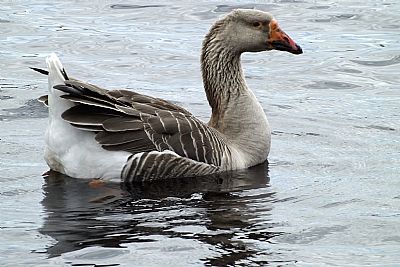GREYLAG GOOSE : Anser anser
If they look rather like domestic geese, thet is because they are considered their ancestor. They are the largest and bulkiest of the wild geese native to the UK and Europe. In many parts of the UK where numbers were dropping it has been re-established by releasing birds in suitable areass. Many such birds, as in the picture below, no longer migrate, but wintering flocks may join them. Large numbers together can be truly impressive. Those that stay can become rather tame.
Thet eat grass, roots, cereal leaves and spilled grain.
Greylag geese are listed in Schedule 2 of the Wildlife and Countryside Act, meaning they can be killed or taken outside of the close season.

While many Greylag Geese migrate, some have decided to settle as here at the Carman Reervoir.

This resident greylag is top goose at Carman Reservoir and keeps everyone from other geese to fishermen and walkers in order.

A greylag gooes eating grass. It systematically swings its head from side to side like a scythe biting as it goes.



A posse of greylag geese have taken to the wall of Carman Reservoir to enjoy the warmth of a June afternoon. Another 30 were out cruising the water.

Just some of the 40 or so greylags on Carman Reservoir in June.
Good place to see them : Carman Reservoir.
NATURE SCOT website : https://www.nature.scot/search?query=geese
RSPB : https://www.rspb.org.uk/birds-and-wildlife/wildlife-guides/bird-a-z/ducks-geese-and-swans/

